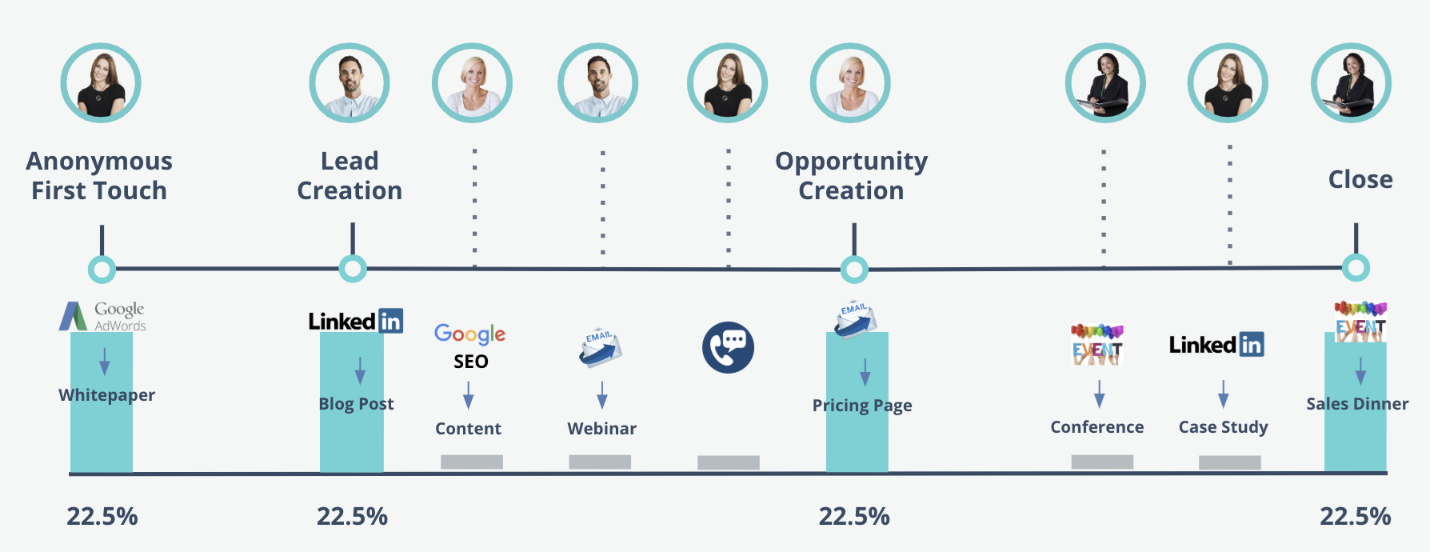
In today’s world, every business is keeping a close watch on budgets and productivity. Marketing departments are no exception to this rule. In fact, marketers may be feeling even more pressure now than in recent years, because economic uncertainties mean that maintaining current budget allotments requires proof of their impact and ROI on the business.
As a result, many marketers seize any opportunity to demonstrate performance. Truth be told, with today’s analytics and reporting tools, it’s easier than ever to understand campaign performance. However, without the proper attribution, it can be difficult to determine which tactics are responsible for an increase in revenue, and in turn, which initiatives are most effective.
That’s where attribution tools like Adobe Marketo Measure (AMM) come in. By identifying which strategies are vital to success and which are less productive, attribution tools offer a detailed view of every interaction and touchpoint during the customer journey. It should come as no surprise that data from Adobe indicates that “95% of B2B Demand Marketers plan to implement or improve marketing attribution in the coming year.”
In addition to identifying touchpoints, tools like AMM provide critical data to inform decisions that frequently affect investments, marketing budgets, and staffing. However, whether you’re preparing to adopt AMM or have inherited it from a predecessor and are learning how to use it, the key to using a tool like AMM means optimizing it to ensure you have the most up-to-date and accurate information.
Let’s dive in to understand more about AMM and how to optimize it.
What is Adobe Marketo Measure (AMM)?
Adobe Marketo Measure, formerly Bizible, is a B2B multi-touch attribution solution that can help marketers and leadership make informed decisions. While many attribution tools deliver insights into the first and last touchpoints, AMM gives users the ability to see every touch points across the entire customer journey. Nearly every marketing dollar can be accounted for and attributed to a specific tactic.
Although campaign membership plays a critical role in AMM, keep in mind it’s an attribution tool and not a campaign reporting tool and may not deliver the campaign performance detail you need. AMM becoming more and more widely adopted because it can provide marketers with both holistic insights and detailed reports that combine data from multiple channels, both online and offline.
Understanding the Difference Between Online & Offline Channels
The beauty of Adobe Marketo Measure lies in having the ability to attribute conversions to touchpoints through the entire customer’s journey, online and offline. Attribution for offline touchpoints can be difficult, but thanks to AMM’s robust features, marketers may find it easier to do than ever.
From organic to paid, AMM can track digital touchpoints while integrations with Marketo Engage, Salesforce and other CRM platforms, allow you to track interactions from offline channels as well. Using AMM, you can determine which channels are bringing in leads and which are converting users to customers, which allows you to focus on the highest-performing channels.
Below are some best practices on attribution for online and offline channels.
Online
AMM uses a tracking script and rules related to utm parameters to properly map your online touchpoints. One of the most important things to keep in mind is that if a channel doesn’t drive traffic to your site, it’s not considered an “online channel.” While you can create your own rules, AMM provides some ‘out-of-the-box’ bracketed rules with built-in logic, like [AdWords Paid Search] or [Facebook Paid] for example. To maintain the bracketed rules, refrain from editing or adding to these rules. Finally, whether you’re using AMM’s rules or your own, make sure you double-check your rules before uploading them since you can’t change the rules for seven days.
Offline
By synching Adobe Marketo Measure to Marketo Engage or Salesforce, you can create offline touchpoints. It’s important to use a deliberate framework during the offline channel mapping process, which involves mapping your Marketo Engage channels to your AMM channels and subchannels or your SFDC Campaign Types to your AMM channels & subchannels You then also need to create rules to specify when you want a touchpoint created based on campaign membership. Additionally, to ensure accurate data, it’s a good idea to be sure you only create truly ‘offline’ touchpoints. If an aspect of an offline event can be tracked as an online touchpoint, say registrations for a conference captured on your website, you want to ensure your offline rule excludes the creation of a touchpoint for registration.
Using Data to Troubleshoot Why Touchpoints are Being Assigned to “Other”
While AMM does a fantastic job at attributing touchpoints to specific channels, there are times when the touchpoints will end up in an ‘other’ category. While initially, this can be frustrating, AMM provides full data backup so you can track down the specific touch point, determine which channel to attribute it to and then adjust your optimization. To troubleshoot the origin of a touchpoint, you can use the following fields: Touchpoint Type, Ad Campaign Name, Landing Page – Raw, or Referral Page – Raw. In addition to improving future attributions, your new rule works retroactively to sort similar “other” attributions into the appropriate channels.
Configuring Your Stage Mapping and Custom Model
With Adobe Marketo Measure, you’re able to get a full-funnel view of what channels prospects are engaging with throughout the buyer journey. You can determine how they found you, and which specific interactions and touchpoints led them to convert, as depicted in the graphic below.

Image Credit: https://experienceleague.adobe.com
To get the best reporting, here are a few best practices to set up your stage mapping and custom models in AMM.
AMM automatically pulls your stages from your CRM. For AMM to properly understand your funnel and progression of records, you must set up your stage mapping in the correct order. Failing to do so could lead to false reporting. The Lead and Contact stage sections are categorized into Open, Lost and Converted while the Opportunity stage section is categorized into Open, Lost and Won. It’s important to make the distinction so your stages are in the correct stage section. It’s also important you avoid using the same name for multiple stages as AMM will simply delete one of them.
When it comes to attribution models, AMM has a stock set of models to choose from, but choosing a custom model gives you control over which touchpoints and custom stages to include. During the initial setup, you’ll add the most important stages to your Custom Model to ensure you get the best reporting. While it’s a good idea to get the stages as close to final as you can, it’s also possible to go back and add them later.
Custom Models have the advantage of using custom attribution percentages across the stages, but if you’re not sure about the percentages, the Marketo Measure Machine Learning Model is a valuable tool. This model features attribution percentages based on how impactful marketing may be at that stage, so the higher the percentage, the more direct influence your marketing has at that stage.
Why Now is the Best Time to Set Up Your Marketers for Success with Adobe Marketo Measure
Adobe Marketo Measure gives your team the ability to look beyond campaign-specific reporting that only looks at first and last touch. Instead, a holistic overview of the entire buyer’s journey, from top-of-funnel to bottom-of-funnel illustrates how marketing influenced each step. Implementing a tool like AMM means that your team no longer has to laboriously compile data from multiple streams or manually manipulate it to get meaningful insights.
By using AMM to streamline the attribution process, your team can focus on optimizing poorly performing areas of the funnel and prioritizing touchpoints that generate strong results. What’s more, not everyone on your team needs to be an expert in AMM to benefit from it. AMM’s integrations with Salesforce and other leading CRMs give your team the ability to identify attributions from within the CRM platform they use most often.
Worth noting, if your company is ahead of the game and already using AMM, but not seeing the kind of results you expected, it could be a relatively simple matter of optimizing AMM for your business BDO Digital can help with this.
Adopting AMM can Economy-Proof Your Marketing Department
Adobe Marketo Measure presents a powerful opportunity to prove the impact of marketing on the buyer’s journey, and most importantly, the company’s revenue. Because setup and optimization of this platform are crucial to successful reporting, this is something my team and I do every day. We help clients in a wide variety of industries get AMM up and running, which includes customizing dashboards and building reports. And if they have an existing AMM setup, we can audit and optimize their platform.
Ultimately, we want our clients to make data-informed decisions about where to spend their efforts and marketing dollars to improve new lead acquisition and sales cycle movement. And that’s a competitive advantage in any economy.
BDO Digital’s team of experts is ready to guide you through AMM setup and optimization. In addition to auditing any existing implementations and supporting new setups, we’re here to support your team on an ongoing basis. To get started, contact us today.

Micheline Farah is a Senior Solution Architect, Adobe Marketo Engage in BDO Digital’s Demand Generation Group. She has an extensive marketing technology background, with over 15 years’ experience implementing, optimizing, integrating, and managing marketing automation platforms, including Adobe Marketo Engage and Oracle Eloqua. Micheline has a passion for combining marketing strategy and technology through multi-channel nurturing, scoring, data cleaning, lead management, and system integrations. She helps her clients build highly effective systems for generating successful and repeatable campaigns with a keen focus on marketing attribution reporting.
The post Understand Marketing’s Impact by Optimizing Adobe Marketo Measure appeared first on DemandGen.





















